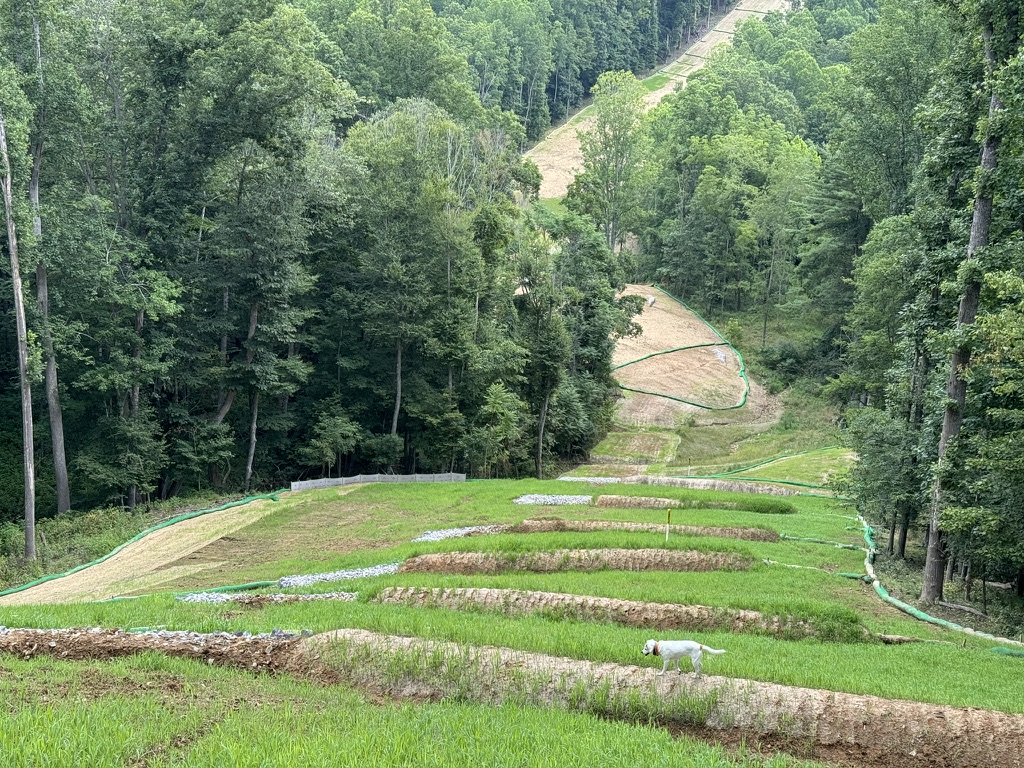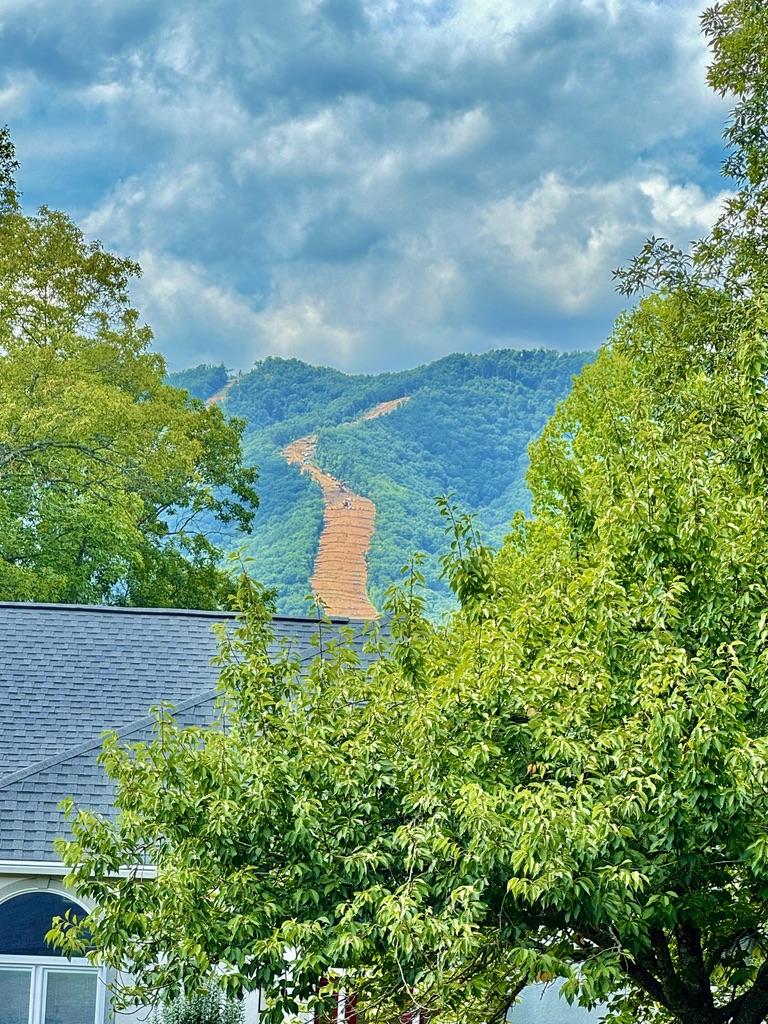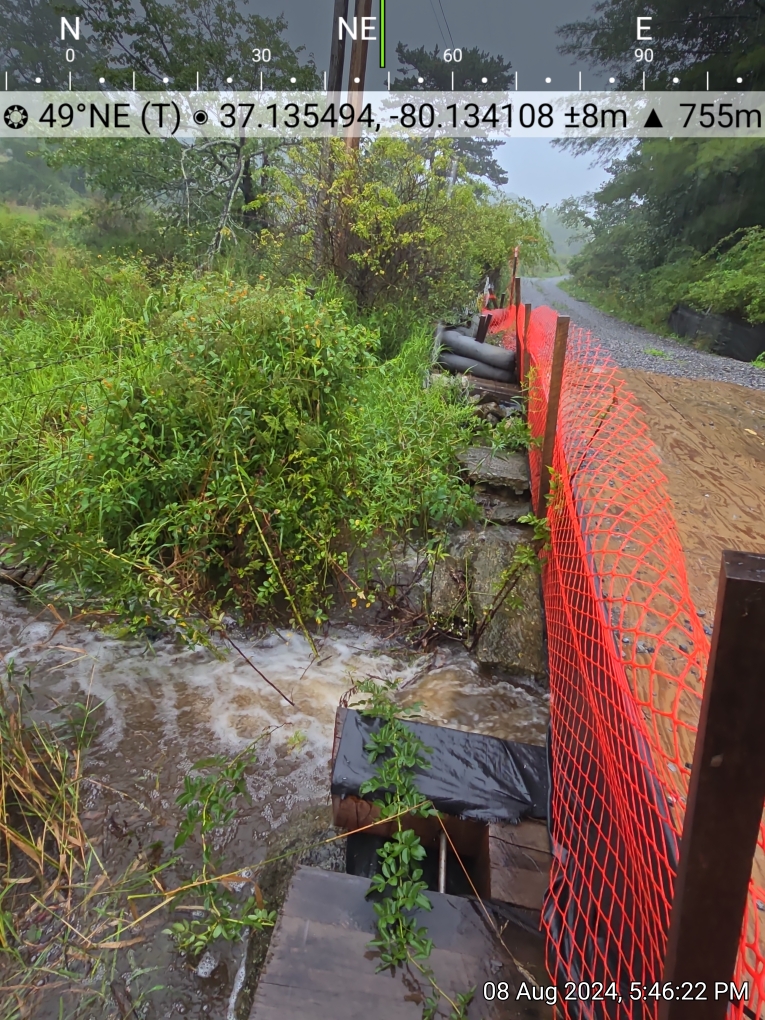Mountain Valley Pipeline’s restoration work causing even more issues

Though Mountain Valley Pipeline went into service in mid-June, construction continues on the route as contractors work to complete final restoration of the right-of-way — returning it as much as they can to its original contour, taking out silt socks, timber mats and other equipment, and installing waterbars and other permanent sediment-control fixtures.
According to landowners along the path of the pipeline and state regulators, MVP continues its documented history of shoddy work and water quality violations in this final stage of construction.
The Virginia Department of Environmental Quality recently hit the pipeline with $30,000 in additional fines for water quality violations, while residents along the pipeline route have multiple complaints about the restoration work.
‘MVP said no’
On Robert Jones’ Montgomery County, Virginia, property, washouts have occurred where MVP only constructed waterbars — earthen berms planted with grass — to divert drainage across the 50-foot permanent right-of-way, leaving the rest of the 125-foot construction right-of-way unprotected.
In early July, heavy rain sent water and sediment rushing down the hill, tearing out sediment socks in the temporary right-of-way, clogging the rock-lined excavated depressions on the edges of the waterbars and depositing mud and dirt into nearby Mill Creek.

Jones’ neighbor Lynda Majors, who helps the retired engineer monitor the right-of-way, discussed the problem with Virginia Department of Environmental Quality Director Michael Rolband and suggested that MVP should put the waterbars across both the temporary and permanent rights of way.
“MVP said no,” Majors says. “They said their contract is over at the end of August. I assume they meant the agreement with their restoration contractor, but MVP is responsible long after that.”
MVP has removed bridges providing access for heavy machinery to the right of way, so cleanup of the July event wasn’t easy.
“There were 12 guys with 5-gallon buckets who worked for five days,” Majors says. “Afterward in Mill Creek, you could see blooms of sediment where fish swam. Mill Creek used to have a gravelly creek bed, but now much of that is covered.”

‘You can’t prove it’s us’
Amy Nelson, a history professor who retired from Virginia Tech two years ago, has been monitoring streams along the pipeline path. Yellow Finch Creek and Sinking Creek are two of the hardest-hit streams she’s seen throughout construction, and the impacts haven’t gotten any better as the company has worked on final restoration.
“There’s a difference between ‘the pipeline is complete and we’re putting gas through it,’ and ‘we’re finished,’” Nelson says. “That’s a huge distinction that is lost in the public imagination.”
A karst contamination event in February — sediment getting into an underground water body that MVP was apparently unaware of — fouled a nearby spring that then dumped sediment into Sinking Creek.
“They didn’t do anything about it for seven days,” she says. “We were used to having pristine or near-perfect water everywhere along the route upstream of Mountain Lake.”
A major landslide near the road to Mountain Lake also caused problems in Sinking Creek.
“They ran into all kinds of problems with that crossing,” Nelson says. “It was nightmarish. It took five months [for MVP to bore] under that creek.”
Repairing the hill was a major project.
“It looks like an amusement park mountain — all rebar and concrete,” she says. “There is nothing natural about it anymore.”
Sinking Creek is nothing like it used to be, and Nelson has little faith that MVP will do what’s necessary to restore it and other impacted creeks, like Yellow Finch.
“Sinking Creek was a trout stream,” she says. “It was a clean stream with no problems. The rocks now have an inch of sediment on them. It’s normal for a stream to be muddy after rain, but a healthy stream will be back to normal in a day or two. Those sites we monitored along Sinking Creek, the water quality is just not okay at any of them anymore. MVP will say, ‘You can’t prove it’s us,’ but it wasn’t like that before. They don’t acknowledge they ruined those streams in the first place, and there’s no effort to restore them.”
According to Nelson, MVP has made lots of promises it has not kept.
“People were told, ‘when we’re done, you won’t know we were here,’” she says. “That’s not what they’re doing. You can’t blast the top off a steep slope and just put it back, especially when you’ve buried a 42-inch pipe bomb there. They are just taking lots and lots of shortcuts and becoming increasingly unresponsive.”

‘This is their responsibility’
Kathy Chandler, who lives on Bent Mountain in Roanoke County, Virginia, has also noticed MVP becoming less responsive as she has tried to get them to deal with problems left behind by their work — most notably on a narrow road that provides access to her property and a couple of neighbors’ homes.
MVP used it as an access road — even though it was cutting through a wetlands area. They dumped tons of gravel on the road and put in timber mat bridges in a couple of locations to handle the heavy machinery coming in and going out.
After the pipeline went into service, MVP came in and pulled out a lot of the silt socks and one of the timber mat bridges. Chandler warned them that the road beneath the other bridge had been destroyed and the culverts beneath it badly clogged by all the sediment coming off the pipeline right-of-way. Pulling up the bridge, she told them, would leave neighbors cut off and make it impossible for emergency vehicles to get through.
“Everybody told me to talk to somebody else,” Chandler says. “I reached out to everybody and heard nothing back.”
At one point, they suggested she could have a contractor repair the road under the bridge.
“I don’t have someone lined up to do the work,” she says. “This is their responsibility.”

When Hurricane Debby — by then a tropical depression — came through the region in early August bringing heavy rains, Chandler took photos of water rushing beneath the timber mats, but over the roadway and clogged culverts.
There are other problems on the road. The portion on her property beyond a gate — which MVP broke and replaced — is now soggy and impassable, for instance. But Chandler hasn’t heard anything from MVP in weeks.
“Now I’m thinking they’re going to stick us with it,” she says. “That’s what it feels like, and that’s not right.”
Related Articles
Latest News

Leave a comment
Your email address will not be published. Required fields are marked *
2 responses to “Mountain Valley Pipeline’s restoration work causing even more issues”
-
Build those pipelines, they are needed especially to build up the electric grids for all the future EV autos ineeding electricity. We have them all over SWVA and they cause no problem and eventually the grass etc will grow over the scared ground and will be almost non noticeable! You liberals want all these EV yet how are you going to power the electric demand in the future, solar panels can’t do it.
-
“World’s largest” carbon capture and sequestration system and CO2 pipelines are pushing their way into the Midwest with the assist of politicians former and current, lotsa money in the equations. Some areas are heavy karst topography, and the company has had poor and secretive communications before any construction has begun. If feels like the beginning of the MVP experience. It breaks my heart to hear and see this in our natural environments and community spaces.





Leave a Comment